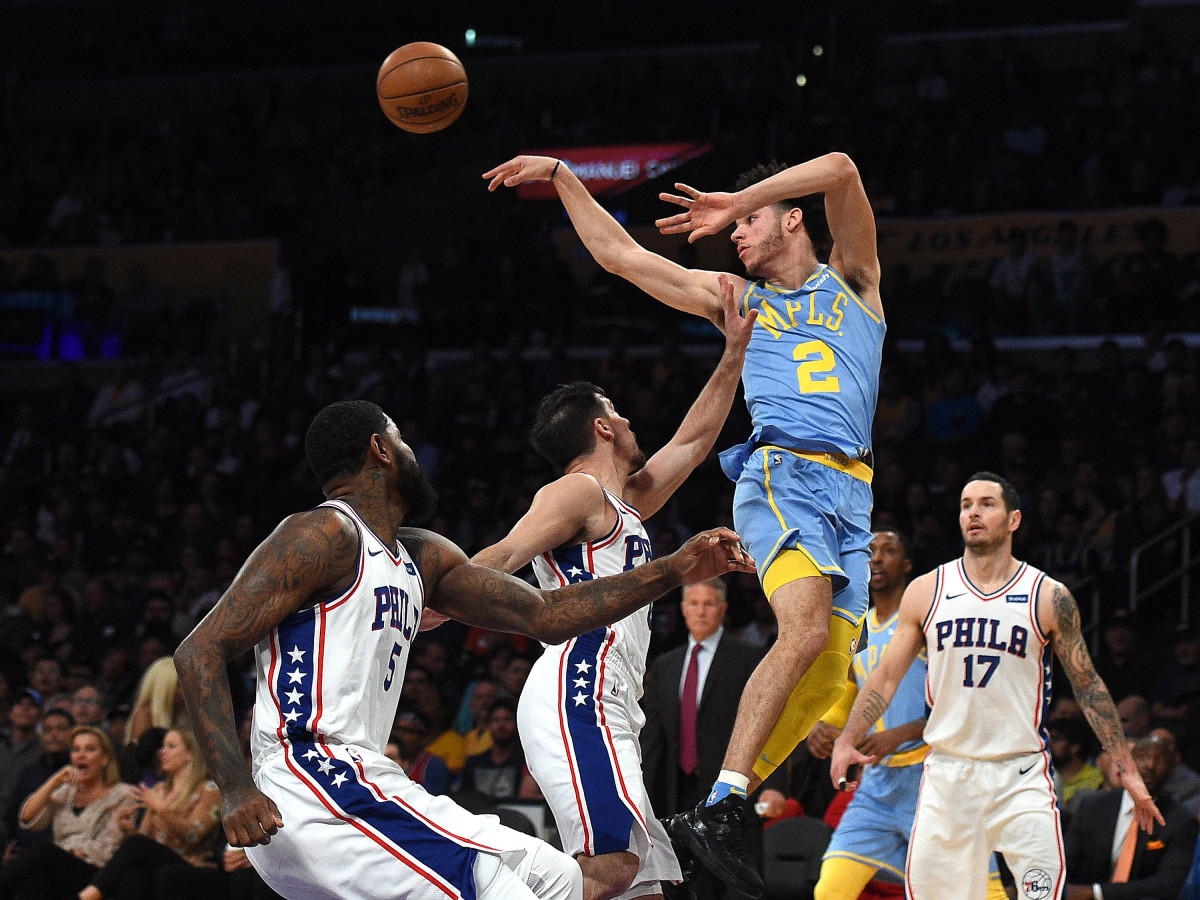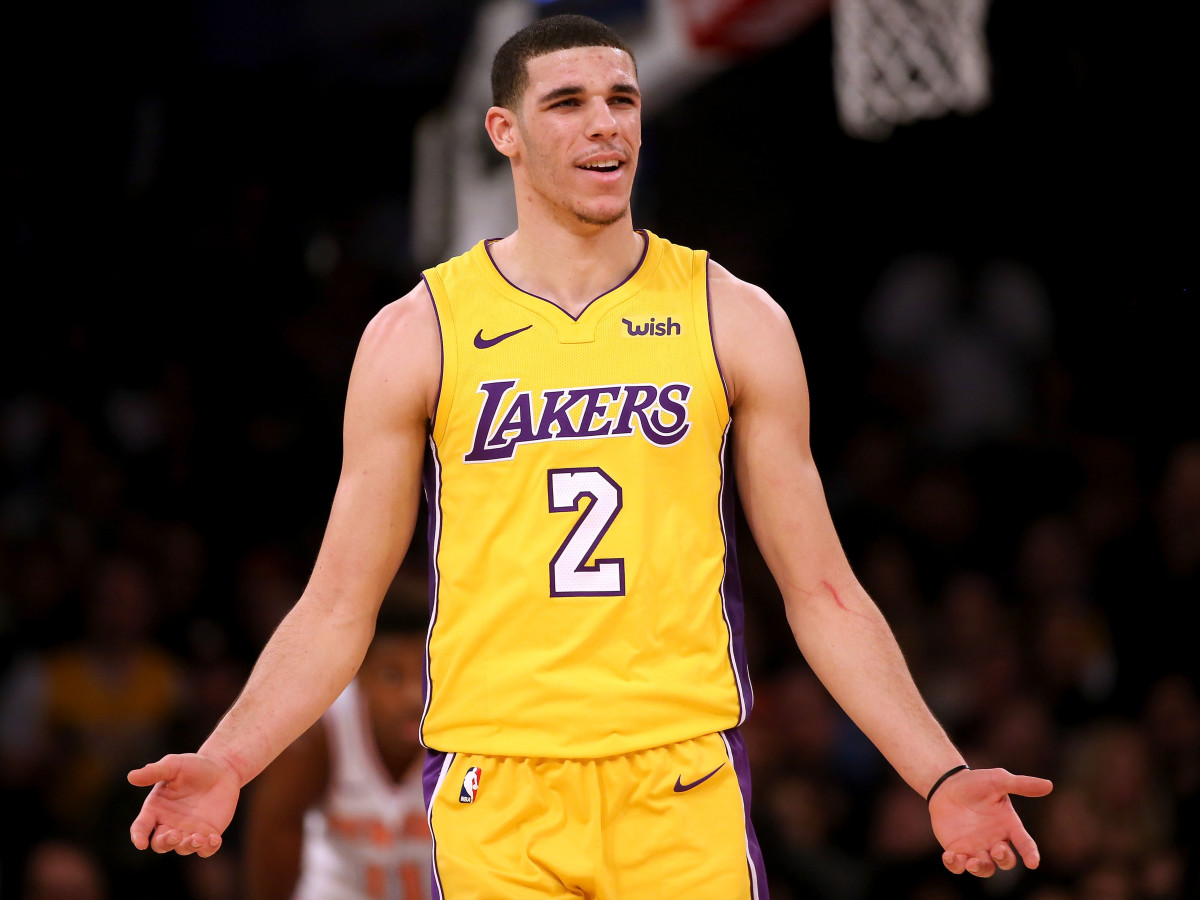The Learning Curve of Lonzo Ball

The evolutionary curve of the NBA has made shooters of most and abandoned most everyone else. We see this most prominently in the big-man ranks, where power forwards and centers are bombing away at historic levels. The long-range shooting of players like Dirk Nowitzki, Rasheed Wallace, and Antoine Walker—once considered relative outliers—now seems almost quaint. The greater license to shoot comes from greater need; NBA defenses, in their growing sophistication, all but demanded optimal spacing from every offense. Basketball tactics are an arms race, and shooting is the great equalizer.
Today's point guards face a concentrated dose of this Darwinian pressure, which is part of what makes Lakers rookie Lonzo Ball such a fascinating test case. Broader trends around the league speak to the importance of a pull-up jumper—the singular threat that changes the way a ball-handler must be defended. Pull-up threats don't only change the positioning of their individual defender, but so many others; ball screens can be negotiated differently when the creator involved can't reliably stop and fire, softening the impact of every drive.
LiAngelo Ball Says He Only Thanked President Trump Because UCLA Made Him
This is where Ball comes in. At this point, the hitch in Ball's shot—in which he swings the ball to his left hip before launching it across his body—is almost as famous as his father's heel act. Burdened by its oppressive delay, Ball has begun his career as literally the worst-shooting rotation player in the league: 38.3% on two-pointers, 25.8% on threes, and a 48.6% from the foul line. Ball is far from the only player to come into the league without a trustworthy jumper, but his shooting scrapes harrowing lows at a time when shooting competence is a virtual requirement.
It would be one thing if Ball could turn the corner like Russell Westbrook or John Wall, thereby forcing opponents to batten down the hatches for every pick-and-roll. He doesn't; for all his speed in the open court, Ball doesn't seem capable of upshifting in a way that would get him consistently to the rim. Ball, by type, wants to probe. Driving appears valuable to him only in the sense that it attracts attention, opening up windows for over-the-shoulder passes to wide open shooters. When Ball can create that momentum, the crispness of his passing proves why he's worth it. When he can't, the offense stalls in a way that calls the whole thing into question.

These are early days for Ball—far too early to affix him with any kind of definite evaluation. At first pass, however, he seems to be the kind of player who makes life easier for his team in certain ways but demonstrably harder for them in others. The Jason Kidd comparisons are apt in that Ball takes the basics seriously. When Kentavious Caldwell-Pope curls around a screen, Ball pays mind to deliver a pass on time and into his shooting pocket. If he has some small part to play in a developing action, Ball plays it to the smallest detail. It's rare for a rookie to mind the nuts and bolts, but Ball makes a living from it, thriving on the simple joy of routine delivery.
The Kidd parallel, however, cuts both ways. There is a reason why his name tends to come up when discussing pass-first point guards: the modern NBA is short on other success stories for lesser scorers at the position. This isn't the 90s or even the early 2000s. The rules have the game have literally changed, and basketball strategy along with them.
LaMelo and LiAngelo Ball Sign With Lithuanian Club
Kidd isn't an archetype. He was exceptional—an all-time great passer, an All-NBA defender, and a champion of late-career development. Kidd thrived when the NBA played a different game and survived the early years of the three-point revolution by finding his shot. Changes in the league since his retirement have only been more demanding of those who would play like Kidd, forcing them to prove their shooting bonafides else they be exploited by opposing defenses.
Plus: The worst-shooting season of Kidd's career came in his second year, when he posted a true shooting percentage of 46.8%. Ball, at present, sits at 39.4%. Even Ricky Rubio, whose limitations as a scorer have made him one of the most complicated players in the league despite his visionary passing and disruptive defense, has never shot worse than 47.6%.

The want to put the offense in Ball's hands is actively sabotaged by the fact that his jumper scares no one. Even Ball himself seems hesitant to unfurl it at times, not quite trusting that he has room and time enough to fire up a clean shot. His pick-and-rolls tend to idle as a result, making him a poor fit for that style of offense. But look around the league: Even offenses that don't lean heavily on pick-and-roll play draw from the shooting threat of their guards to be successful. You can't exactly run Ball around off-ball screens because his shooting form develops so slowly—allowing a defender precious time to catch up. Even when Ball does attempt threes, so many come from well behind the line out of practical necessity.
How can a team fully reconcile the winning plays Ball makes—the over-the-top passes with perfect placement, the hustle rebounds, the intuitive defense—with his troublesome fit? This is the question the Lakers drafted into, and its answer will require nuanced execution and near-constant creativity. The league is already wise to what Ball can and cannot do. Winning consistently will require subverting certain expectations, be it by shooting when opponents think Ball might not or by creating situational advantages with smart footwork.
Stephen Curry Q&A: 'I Shocked the Shoe Game'
Ball, in contrast to both his spotlit position with the Lakers and his father's claims, is actually quite a subtle player. His way forward lies on that route, less in shot overhauls than in targeted refinement. Clean up the handle a bit and maybe Ball looks that much more explosive off the dribble. Set up his pick-and-rolls with clever preliminary action and maybe you'll throw the defense off balance. This is a time for experimentation. Ball has the want and the feel to make plays, along with some of the means. Progress will come when he learns how to push, even as the NBA game itself pushes back.
